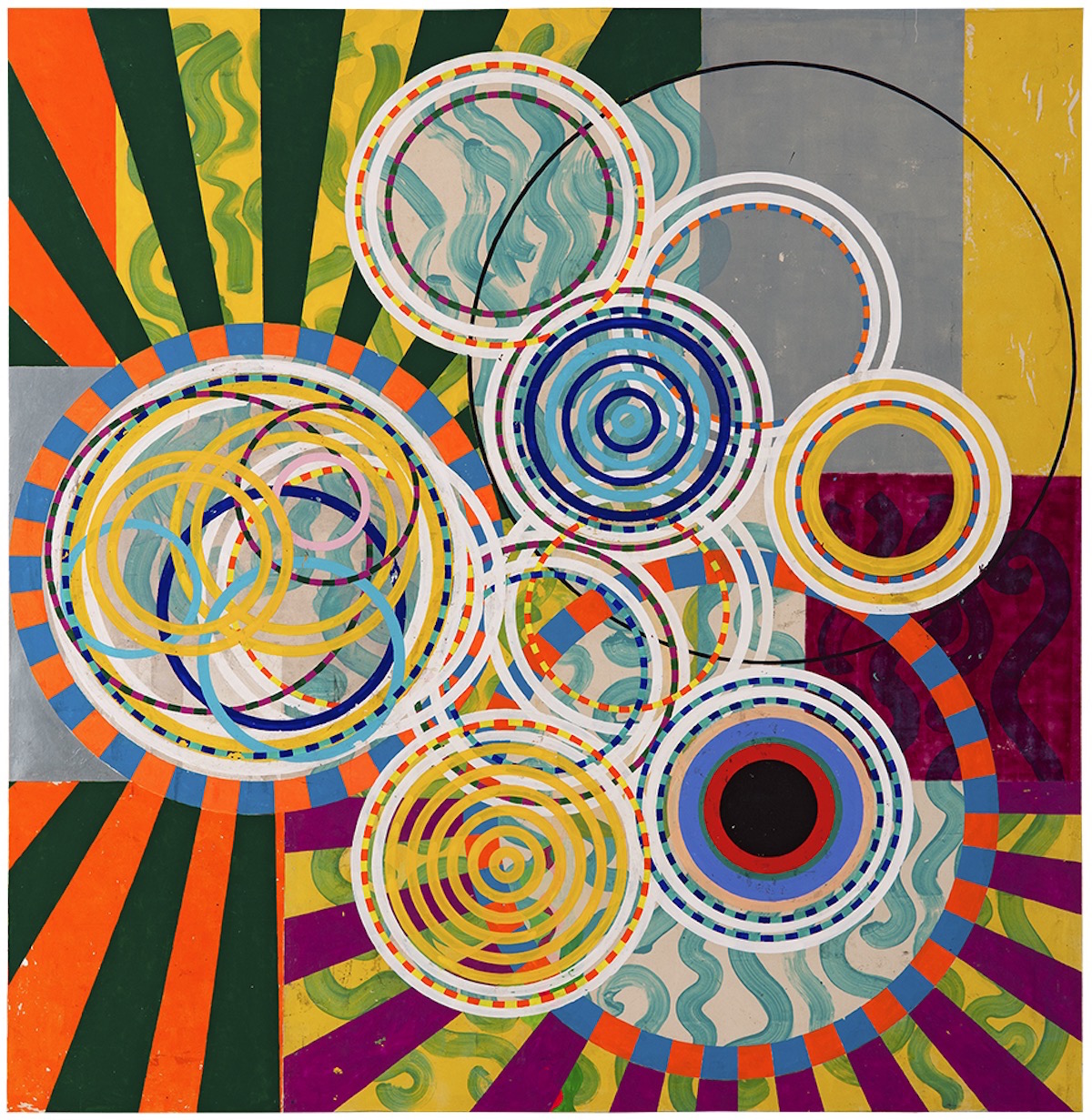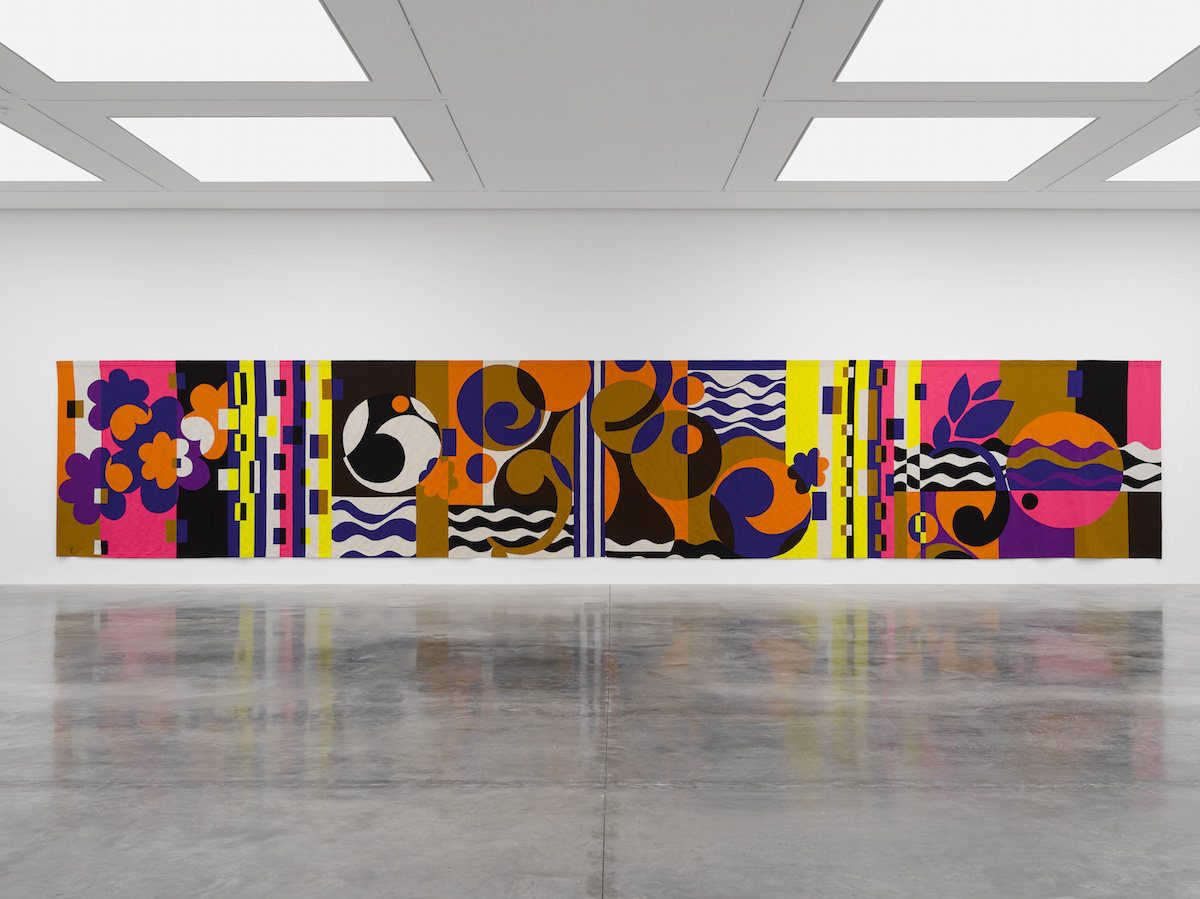
Psychedelic spirals and optical illusions freewheel in the work of Beatriz Milhazes. While she is first and foremost a painter, more recent explorations have led her to a variety of media including painting, installation, sculpture and collage. She is currently exhibiting a large-scale new body of work at White Cube Bermondsey, London, which includes her first-ever tapestry, created especially for the show. At sixteen metres wide, it dominates the space with dynamic geometric blocks, circles, leaves and flowers, as if to create a kind of kinetic landscape. Symbolism and a certain playfulness with perception come together to create a riot of solid colour and shape that recall everyone from Matisse to Sonia Delaunay.
The tropical gardens of her native Brazil are hinted at in floral compositions, while gridded and interlocking lines suggest the distinctive modernist architecture of such figures as Lina Bo Bardi. The influence of Swedish painter Hilma af Klint, now regarded as one of the pioneers of abstract art, can also be felt; both artists explore mathematical and scientific concepts in their deeply personal works, which are as meditative as they are energetic.
You currently have a show on at White Cube in Bermondsey. Can you tell me a bit about it?
This is a singular exhibition. The beautiful and incredible space of the White Cube Bermondsey gallery couldn’t be a more challenging departure for a project. It was an opportunity to create a real dialogue between painting, collage, sculpture, the installation Gamboa II and tapestry. Everything starts and finishes with the paintings—painting is the root of my thoughts and concepts. I would say that every painting here is a result of a mathematical dream. However, this exhibition is also an invitation to the visitors to walk through the different mediums I’ve been developing for decades.

As well as pieces for gallery spaces, you have also made large-scale public artworks, such as Peace and Love in Gloucester Road tube station in London. What are the benefits and limitations of working with public art, and which do you prefer?
I’m a studio artist. My studio is the home for my thoughts to become an artwork, where if something has to happen, it will happen in the studio first. To develop large-scale public artworks has been a big but exciting challenge. The limitations are the benefits, they are what challenges you, and have brought new questions to my studio practice. It also helps my art to communicate in a different dimension with the audience.
“Every painting here is a result of a mathematical dream”
To me, there’s a relationship between your work and that of Hilma af Klint. Who would you cite as inspirations?
I was amazed when, in 2013, I received a message from a curator at Moderna Museet Malmö on the occasion of the Hilma af Klint retrospective organized by this museum. Honestly, that was the first time I’d heard about her work but I totally understood the connection they made and since then I’ve been reading and seeing her work in person whenever possible. What we most have in common is the scientific approach she had as an artist. I feel very connected with it too.
The three artists who most influenced my work and are still a strong reference are Tarsila do Amaral, Henri Matisse and Piet Mondrian. For the last five years I’ve been using elements and motifs from abstract art history in my compositions, and I can cite Sonia Delaunay, Aboriginal art, Kadiweu Brazilian tribe, Brazilian neo-concretism, Bridget Riley, Ione Saldanha, Cruz-Diez, Hilma af Klint, Niobe Xandó.

“I am someone who needs nature around as an atmosphere to motivate me to create”
You have previously said that you’re very moved by nature. Could you tell me a little about how your surroundings become translated into your works?
Rio de Janeiro, where I was born, grew up, live and work, is a very beautiful city with an abundant and real nature together with an urban geography. My studio is next to the Botanic Garden in a neighbourhood that has a countryside atmosphere and is part of the Rio history. My work only recently has had the need to observe real nature; to observe real flowers and plants and use them as references in my drawings has only happened in the last decade. Before then I would say that applied art and decorative art were mostly my sources of observation. I am someone who needs nature around as an atmosphere to motivate me to create.

You have spoken a lot about your painting process involving a decal technique. In the White Cube exhibition you will also be showing sculptural work—do you find similarities between the way you produce sculpture and painting?
In this exhibition it is possible to see Gamboa II, which is an installation that originates from a stage set I did in 2004 for the Marcia Milhazes Dance Company, and how it influences my process of making the three sculptures Marola, Mariola and Marilola. The Gamboa II series was my introduction to the three-dimensional field. Marola, Mariola and Marilola, I regard as my first three sculptures. While their roots come from Gamboa II series, they are about different sources of materials that have often attracted me: volume, density, balance. The templates that hold all elements were two-dimensional metal cut-out drawings that, when turned over, gave the key to start the process of construction and object. My work is very much about process, and both painting and sculpture have the same root as they are about process. However, painting is always about something else.
Installation Images, Beatriz Milhazes, Rio Azul, White Cube Bermondsey 17 April – 1 July 2018 © Beatriz Milhazes. Photo © White Cube (Ollie Hammick)






